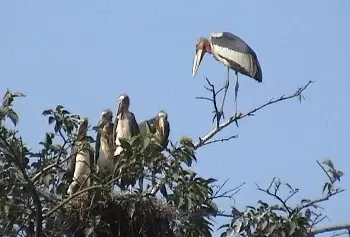World’s third nestling spot for the ‘Leptoptilos dubius’ species is in Bihar
17-November-2011
Vol 2 | Issue 46
The mythical Garuda is staging a comeback - only this time in reality. Four years after these endangered birds of the stork family started nesting and breeding in Bihar's Bhagalpur district, their number has increased fourfold - from 78 to over 300.
"A fourfold increase is not only a positive development but a matter of celebration," said Arvind Mishra, coordinator in Bihar and Jharkhand for the Indian Birds Conservation Network.
 |
|
The population of Greater Adjutant or Garuda has grown from 78 to 300 in four years (Photos: Arvind Mishra)
|
"In 2007, only 78 Garudas were counted in the district," said Mishra over phone from Bhagalpur, 200 km from here, adding that now the birds are over 300 in number.
According to Mishra, it is a result of the conservation drive started by environmentalists and bird lovers with the help of local villagers. "We have created awareness among local people about their conservation and protection."
In Indian mythology, Garuda is considered the 'vahan' or carrier of god Vishnu.
Loss of nesting habitat and feeding sites through drainage, pollution and disturbance, together with hunting and egg collection, caused a massive dip in the population of the species.
Mishra first spotted the Garuda birds nesting and breeding in 2007 on a silk cotton tree near a village in the Ganga-Diara area in Bhagalpur. Prior to this, the species had never been seen in Bihar during its breeding period.
"I was excited when I found the endangered Garuda breeding in the flood plains (Diara) of the Ganga and Kosi rivers in the district for the first time," Mishra said.
The birds face very high risk of extinction if proper conservation efforts were not taken, he added.
Mishra, who has been studying birds and conducting surveys for conservation, said: "The birds are on the verge of extinction. Attempts are being made all over the world to conserve and save them."
There are only 1,100 Garuda birds, which are migratory in nature, around the world.
The Garuda, biologically known as Greater Adjutant, is classified as endangered on the International Union for Conservation of Nature (IUCN) Red List 2004 of threatened species and listed under Schedule IV of the Indian Wildlife (Protection) Act, 1972.
The large wading bird belongs to the Leptoptilos dubius species.
 |
|
Arvind Mishra attributes the growing population of the birds to conservation efforts of bird lovers and villagers
|
This huge stork has a naked pink head, a very thick yellow bill and a low-hanging neck pouch. The neck ruff is white. The bird looks like a vulture. Other than the pale grey edge on each wing, the rest of the Greater Adjutant's body is dark grey.
Juveniles have a narrower bill, thicker down on the head and neck, and entirely dark wings, Mishra said. A Garuda bird measures 145-150 cm (about three feet) in length and four to five feet in height.
Mandar Nature Club officials in Bhagalpur, working hard to create awareness among the locals on the need for protecting the birds, said villagers were proud that the Garuda birds have chosen this place for shelter and breeding.
He said the nesting season of the birds is between September and January. The nests, usually built right on the top of the tree canopy, measure 90-110 cm in diameter.
The Greater Adjutant was formerly found in South and Southeast Asia but now it breeds only in Assam and Bhagalpur in India, and in Cambodia.
"Bhagalpur is the third nesting region of this species in the world," said Mishra, who has been working on a project supported by the Wildlife Trust of India for the protection of the species.
"This could be a good sign for the survival of a good number of the species," he added. - IANS














